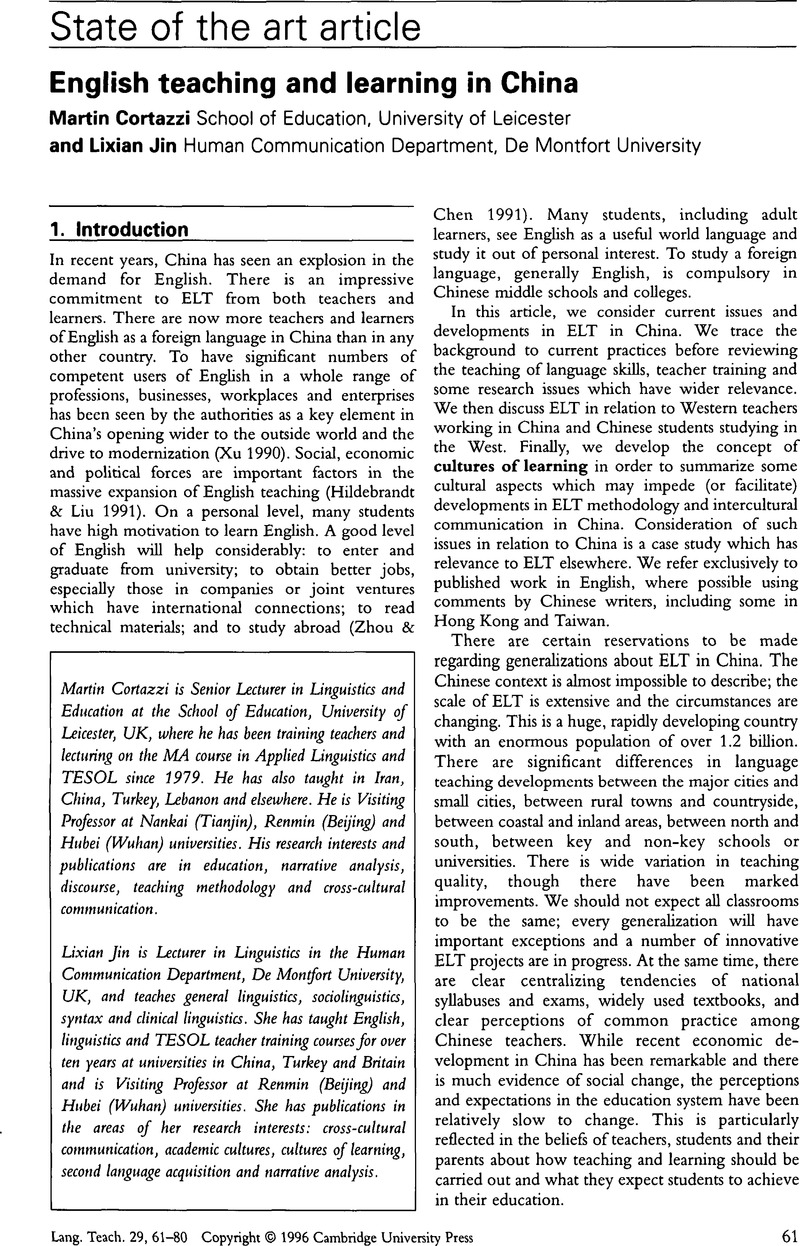Crossref Citations
This article has been cited by the following publications. This list is generated based on data provided by Crossref.
Bamford, Julian
and
Day, Richard R.
1998.
Teaching Reading.
Annual Review of Applied Linguistics,
Vol. 18,
Issue. ,
p.
124.
Wang, Yinquan
1999.
‘College english’ in China.
English Today,
Vol. 15,
Issue. 1,
p.
45.
Dakun, Wang
1999.
Promoting Communicative Activities in Grammar Teaching in China.
Asian Englishes,
Vol. 2,
Issue. 1,
p.
121.
Boyle, Joseph
2000.
Education for Teachers of English in China.
Journal of Education for Teaching,
Vol. 26,
Issue. 2,
p.
147.
Zhang, Lawrence Jun
2000.
A canon of wider choice.
English Today,
Vol. 16,
Issue. 3,
p.
55.
Jin, Lixian
and
Cortazzi, Martin
2002.
English Language Teaching in China: A Bridge to the Future.
Asia Pacific Journal of Education,
Vol. 22,
Issue. 2,
p.
53.
Ouyang, Huhua
2003.
Local Meanings, Global Schooling.
p.
121.
Kiely, Richard
2003.
What works for you? A group discussion approach to programme evaluation.
Studies in Educational Evaluation,
Vol. 29,
Issue. 4,
p.
293.
Chan, Alice Y. W.
2004.
Syntactic Transfer: Evidence from the Interlanguage of Hong Kong Chinese ESL Learners.
The Modern Language Journal,
Vol. 88,
Issue. 1,
p.
56.
Zhang, Lawrence
2004.
Awareness-Raising in the TEFL Phonology Classroom.
ITL - International Journal of Applied Linguistics,
Vol. 145-146,
Issue. ,
p.
219.
Hu, Guangwei
2005.
English Language Education in China: Policies, Progress, and Problems.
Language Policy,
Vol. 4,
Issue. 1,
p.
5.
Hu, Guangwei
2005.
Building a Strong Contingent of Secondary English-as-a-Foreign-Language Teachers in China: Problems and Policies.
International Journal of Educational Reform,
Vol. 14,
Issue. 4,
p.
454.
Hu, Guangwei
2005.
Professional Development of Secondary EFL Teachers: Lessons from China.
Teachers College Record: The Voice of Scholarship in Education,
Vol. 107,
Issue. 4,
p.
654.
Hu, Guangwei
2005.
Reforms of Basic English-Language Education in China: An Overview.
International Journal of Educational Reform,
Vol. 14,
Issue. 2,
p.
140.
Feng, Anwei
2005.
Bilingualism for the Minor or the Major? An Evaluative Analysis of Parallel Conceptions in China.
International Journal of Bilingual Education and Bilingualism,
Vol. 8,
Issue. 6,
p.
529.
Huang, Jing
2005.
A diary study of difficulties and constraints in EFL learning.
System,
Vol. 33,
Issue. 4,
p.
609.
Edwards, Rachel
2006.
What's in a Name? Chinese Learners and the Practice of Adopting ‘English’ Names.
Language, Culture and Curriculum,
Vol. 19,
Issue. 1,
p.
90.
Evans, Stephen
2006.
The Beginnings of English Language Teaching in China.
Asian Englishes,
Vol. 9,
Issue. 1,
p.
42.
Jin, Lixian
and
Cortazzi, Martin
2006.
Changing Practices in Chinese Cultures of Learning.
Language, Culture and Curriculum,
Vol. 19,
Issue. 1,
p.
5.
Lamie, Judith M.
2006.
Teacher education and training in China: evaluating change with Chinese lecturers of English.
Journal of In-Service Education,
Vol. 32,
Issue. 1,
p.
63.


